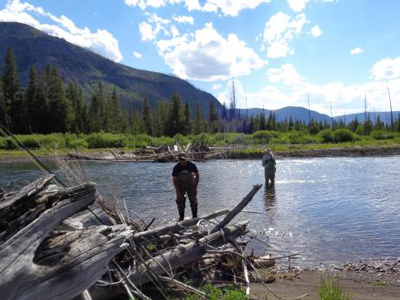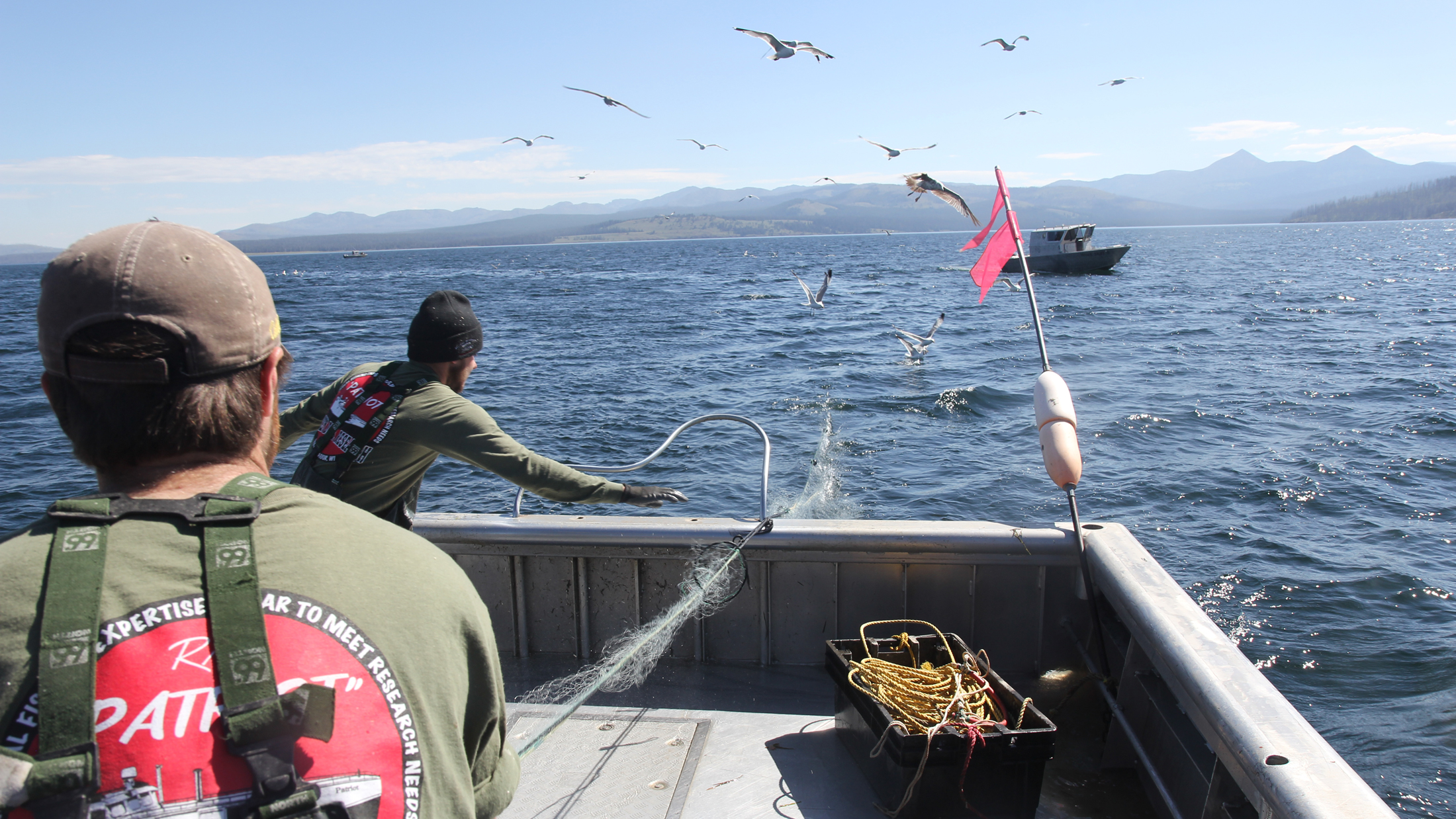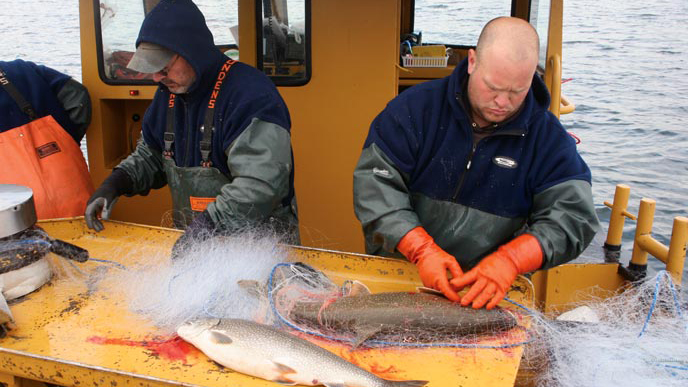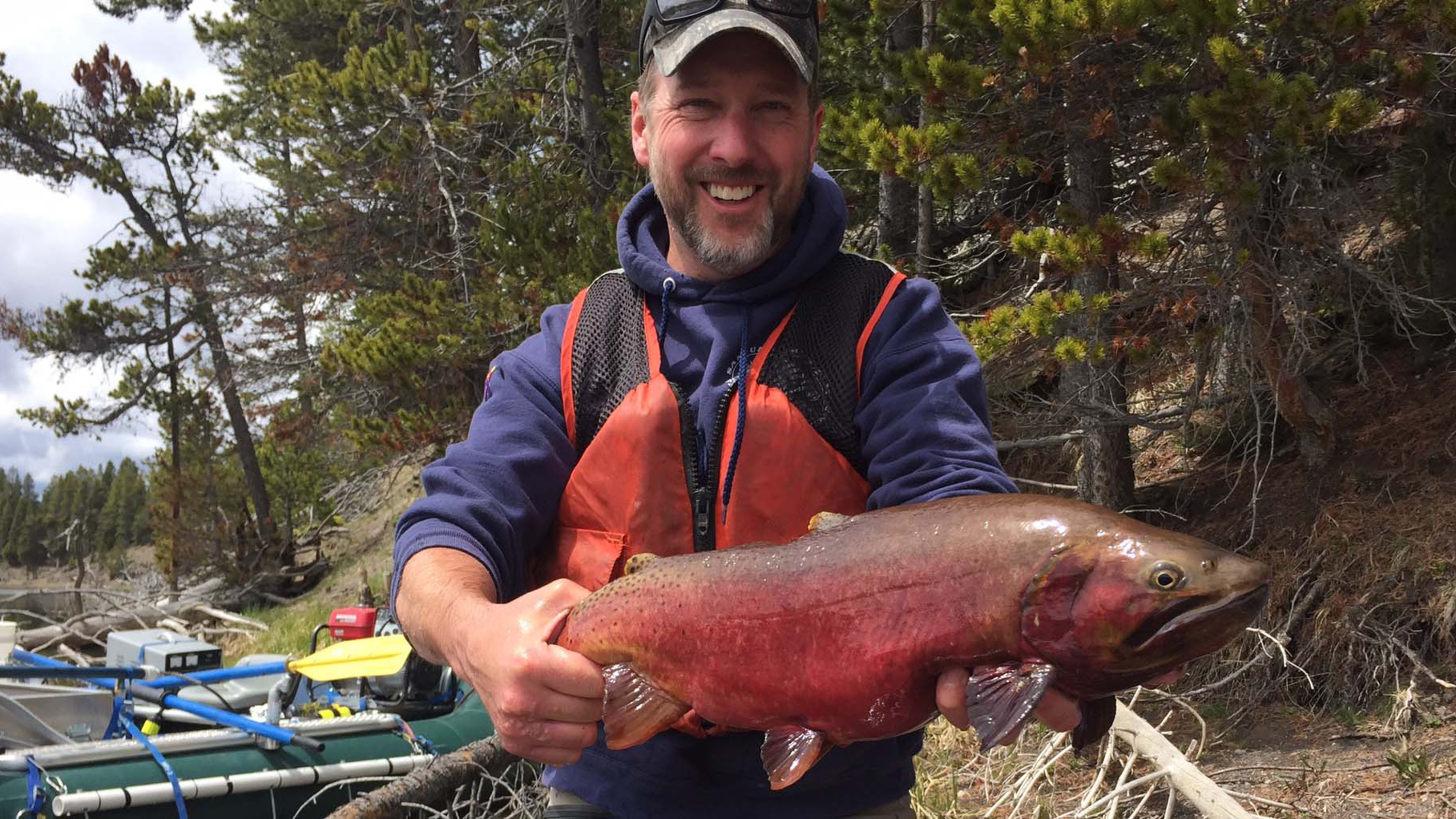I’ve stepped into an adventure on the high seas, or so it would appear. As I board the boat, men clad in thick rubber rain gear spool out gillnets into the water, deftly making sure the net stays straight and uncoiled. Overhead, gulls circle and raucously call, occasionally pelting me with their droppings. Pelicans follow the boat. The air smells of fish and fuel. Crates of the day’s catch are stacked on deck. The boat rocks with the swells as it continues to lay out net.
But I’m far from any ocean. I’m in Yellowstone National Park, surrounded by mountains and bison and geysers.
On the summer we recognize the 100th anniversary of the National Park Service, I’m at our first national park – and one of my favorite places on earth – on a commercial gillnetting boat. That seems a strange way to celebrate.
But I’m here to see the righting of a wrong, a chance to restore a key part of the Yellowstone National Park ecosystem.
Those gillnets are part of one of the most ambitious native fish restoration efforts ever undertaken, attempting to control invasive, non-native lake trout so that native Yellowstone cutthroat trout can return.
The Fall of the House of Cutthroat
I’m a child of outdoor magazines and books: their stories of adventure inspired in me a desire to see and experience the world’s wild places. I created lists of where I wanted to go and things I wanted to do. One of those classic experiences was cutthroat trout fishing in the Yellowstone River. Every year, it seemed, there’d be another story of an angler catching dozens of cutthroats in an afternoon, all on dry flies. It seemed too good to be true. And it was.

By the time I first visited Yellowstone National Park in 2001, the Yellowstone River’s cutthroat fishery was a pale shadow of its former self. Catching a single fish in an afternoon became an achievement. Few anglers lined the banks because the word was out: the cutthroats had essentially disappeared.
What happened?
In 1994, a fishing boat on Lake Yellowstone reported an unusual catch: a lake trout. Lake trout are not native to Yellowstone, although they had been stocked in nearby Lewis Lake decades prior.
Exactly how they got there is unclear, and perhaps irrelevant. What soon became clear is the impact they would have on cutthroat trout, and an entire ecosystem.
Lake Yellowstone is the largest body of water in the park. It also is connected to numerous rivers and streams, most notably the Yellowstone River. Cutthroat trout live in the lake and also migrate out to spawn each year. At one point, the population in this system numbered 3.5 to 4 million trout: a highly productive fishery.
It soon became apparent, though, that Lake Yellowstone was also highly productive for invasive lake trout. “One of the really hard things here is that this lake is really good lake trout habitat,” says Pat Bigelow, National Park Service biologist. “Lake trout here have 2.5 times better survival than a typical, native lake trout population. They don’t have any predators.”
Biologists recognized the situation as dire: By the 2000s, the Yellowstone cutthroat population had declined by 95 percent.
This affected more than the storied sport fishing. Yellowstone cutthroat literally feed an ecosystem: grizzlies and ospreys and otters and more dine on the trout on their spawning run. The trout were highly migratory, and could spawn as far as 30 or 40 miles from the lake – providing food for predators over a wide geographic area.
Lake trout, in contrast, spend much of their time in the lake’s deep water – so they are not available to grizzlies and other predators.

Essentially, a key part of the ecosystem had been functionally eliminated. Looking out over the vastness of Yellowstone Lake, conservationists wondered: was it already too late?
Instead of wallowing in this despair, they launched an ambitious and perhaps even audacious plan to knock back the lake trout population.
We made a commitment to restore the fishery to historic population levels. We are not done here. That’s the bottom line.
Dan Wenk
Brett Prettyman, Intermountain communications director for Trout Unlimited, invited me to see that effort firsthand.
A Brief History of Fish in National Parks
We’re looking at gillnetting boats, currently the major strategy in reducing the lake trout population. Using commercial fishing techniques in a national park in itself seems somewhat revolutionary.
“This is just one part of a park-wide program focused on native fish restoration and preservation,” says Todd Koel, National Park Service biologist.
He pulls up a map outlining projects around the park aimed to bringing back fish including grayling, Westslope cutthroat trout and other Yellowstone cutthroat trout populations. To a 21st century conservationist, this might seem a given in our national parks. But it wasn’t always that way.
In the early history of the national parks, managers often actively stocked non-native fish as part of their conservation program. At the time, it was believed that hatchery stocking helped sustain fish populations and fishing opportunities. Many anglers wanted to catch fish species they were familiar with, and the Park Service was happy to oblige.
In the 1930s, some park biologists began arguing against stocking, but societal values were not there yet. The main goal was to provide fish for anglers to catch – and eat.
According to Koel, it was not until the 1970s that park managers began aggressively promoting practices like catch and release, and attempting to preserve native fish. “It took a long time for the public to catch up,” he says.

As he was sharing this history along the shores of Lake Yellowstone, an older man approached and began gesturing wildly. “The National Park Service could have avoided this whole situation if you had just killed the lake trout in Lewis Lake in the 70s,” he said, referring to a lake where lake trout had been intentionally stocked in the earlier days of Yellowstone. “It was stupid. It’s your fault. You could have stopped this.”
Koel calmly replied, “We could have never convinced the public of that in the 70s, even if we had known the threat.”
The man stormed off, still muttering about the folly of the Park Service. “It just shows the passion people have for native fish,” says Dave Sweet, Yellowstone Lake special project manager for Trout Unlimited. “There are a lot of opinions, but people now care about the fate of native fish.”

Many anglers, myself included, want to catch the native species wherever we fish, not just the same non-natives. Park visitors enjoy watching cutthroats on their spawning runs, and recognize their importance to other wildlife.
We can’t go back decades and change the past’s policies, values and worldviews. But right here, right now, conservationists can make a difference in Yellowstone cutthroat restoration.
Bring on the Boats
Five years ago, gillnetting boats launched onto Lake Yellowstone, plying the waters for lake trout. Biologists determined that only a large-scale effort could dent the invasive population, so just asking lake sport anglers to keep lake trout would never be sufficient.
The boats lay out miles of net at a time, and pick them up 3 or 4 days later. They keep detailed records of location and rate of catch, and that location helps direct where future efforts concentrate.
“This is science based, but to work sometimes it comes down to fishing sense,” says Todd Koel. “It’s knowing where to go, what tactics to use and recognizing that sometimes catching fish is just dumb luck.”
The sustained effort has yielded significant numbers: more than 1.2 million lake trout have been removed to date. The bycatch of Yellowstone cutthroat is insignificant.
This summer, more than 200,000 lake trout had been removed at the time of my visit. As I stood on the boat, filled with the carcasses of more than 1,200 lake trout from just one day, I wondered at the Sisyphean nature of the task. The fishers removed nets filled with invasives, and the next day found even more invasives in their nets. It seemed the supply of lake trout was endless.

And that’s part of the challenge: this isn’t a short-term project. Biologists project, based on information about lake trout commercial fisheries in the Great Lakes, that it will take another 7 years for the Yellowstone Lake lake trout population to reach that tipping point where the population crashes.
That takes money and resolve, and it’s clear the National Park Service can’t do it alone. The Yellowstone Park Foundation, Trout Unlimited and other partners have pitched in to ensure that momentum keeps up.
“You can’t make a 5-year commitment to this and then say you’re done,” says Dan Wenk, Yellowstone National Park superintendent. “That would be throwing money away.”

Wenk recognizes native fish conservation as one of his highest priorities in the park. “We made a commitment to restore the fishery to historic population levels,” he says. “We are not done here. That’s the bottom line.”
He also tells me that the seemingly never-ending nets filled with invasives is not as bleak as it may appear. “Yes, we are seeing the same numbers, but we have to spend more effort to catch those same numbers of lake trout,” he says.
In other words, the crews have to work harder to find invasives. But even if the gillnetting can crash the population, the work is not done.
“It’s unlikely we’ll ever be able to completely eliminate lake trout from Yellowstone Lake,” Wenk says.
That means finding other ways to control the population. Trout Unlimited has funded tracking devices planted in lake trout so that biologists can see where they are spawning. The spawning beds, located in shallow lake waters, will be another focus of the control effort. Academic collaborators are helping devise effective techniques for killing eggs and making spawning sites unattractive. Potential strategies include electroshocking eggs and placing decomposing trout carcasses on the spawning beds.
“Hopefully a combination of these tactics will allow us to manage lake trout to the point where Yellowstone cutthroat can thrive,” says Wenk.
Reasons for Hope
And while that may seem a long way off, lately it’s hard to miss some promising signs. This summer, for instance, fishing guides began posting videos from wilderness tributaries of Yellowstone Lake, showing clients catching cutthroats of significant size. Many outfitters had stopped these trips due to a lack of fish, but it was clear that fish were returning.
Other videos documented grizzly bears actively hunting and feeding on cutthroats in Yellowstone Lake tributaries. Angler numbers are up. “There are some really good signals,” says Todd Koel.
Indeed, as I drive out of the park, I can’t help but notice anglers lined up on the legendary stretches of the Yellowstone River – places where I had hardly seen anyone fishing for the past 10 years.
I felt tempted to stop, but as Robert Frost wrote, I had promises to keep and miles to go before I sleep. But I vowed to return next summer. I fully expect there to be native Yellowstone cutthroats feeding in front of me.
That won’t be due to luck or even just nature. It will be due to that heroic effort happening a short distance away, gillnets and fishers deployed in the latest chapter of national park heroics.



Great memories of fishing the north shore of Yellowstone in 1986 and following: in bellyboats, a Colorado buddy and I fished a couple afternoons several summers with barbless woolybuggers (et. al.). We would catch and release 30-50 cutts from 12 to 17″ (some 19-21″) before sundown. By 1990 or so, we were catching fewer and larger fish and more than a few would show flesh wounds (sometimes chunks of trout were gone from their bodies). Finally, our favorite lake spots seemed bare of all but a dribble of Cutthroat Trout. Of course, we had heard of the intrusion, perhaps many years past, of Lake Trout. I, also, recall a trip to the third meadow on Slough just a few years back; I landed a 14″ Rainbow. It felt a bit odd to knock it in the head and cast it aside.
Terrific article and hope the lake can be restored.
I would really like to know what happens to all the lake trout too…I REALLY hope they are fed to someone!
I don’t “drown worms” (this non-fisherperson’s way of looking at it), but unlike some friends who are hooked on fishing and to whom a catch is a catch is a catch, I find Yellowstone’s Cutthroat an aquatic rose by no other name. I live on the Third Coast, Chicago, where sports and commercial fishing is a whale of an industry. Great efforts are under way to tackle nonnative species such as Asian Carp. Kudos to our regional conservationists who either catch heck about wasting time and taxpayers’ money to reverse the flow of invasives into waterways, or, maybe even more daunting a task, trying to raise awareness of the ecological and legal consequences of dumping leftover baitfish, like the Goby that Bass enjoy, into the system. Thanks for the great article and visuals. I reely enjoyed it!
what happens to the culled lake trout carcasses? do they go on to become food for people or animals? are parts composted for fertilizer?
I grew up on Flathead Lake in western Montana. At that time (40’s to 70’s ) the lake was literally filled with Kokanee. I could go out as a child and come home with a limit day after day. Then the Fish and Game Dept. decided to introduce brine shrimp upon which the Mackinaw flourished. They also ate all the Kokanee eggs and fry. Today there are no Kokanee left, few if any Dolly Varden, and no Cutthroat.
There are over 1.6 million Mackinaw in Flathead Lake today.
This has to be one of the worst decisions ever made by the Fish and Game and can never be undone.
Heartbreaking.
I guess trout is going to be a cheap meal around there for a while. Are there any places that need lake trout?
What happens with all the fish that have been caught? Are they donated to a homeless shelter or animal group? I would hope they aren’t just thrown away. Great article!
In 2006 I fished Yellowstone Lake in the West Thumb. In four hours I landed over 2 fix cuts some over 3 to 4 pounds.
I was with a guide from Jack Dennise’s shop in Jackson Hole. He had a small motor on the drift boat.